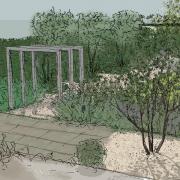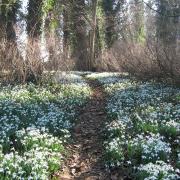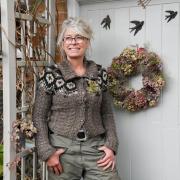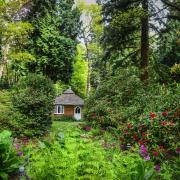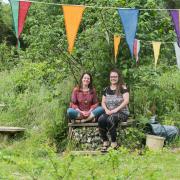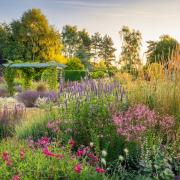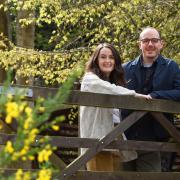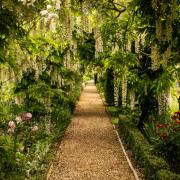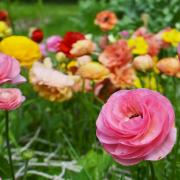Serena Shores meets award-winning master craftsman Brian Turner and sees some of the fantastic leadwork masterpieces gracing county gardens

From car exhaust fumes, to fishing weights poisoning swans, the toxicity of plumbum has often given it a bad press. But its use has been traced back many thousands of years and the unique properties of this silver-grey metal, are, when admired as a decorative art form, not only literally timeless, but somehow subtle and regal at the same time.
“Lead fumes at 500 degrees centigrade and evaporates at 1,000,” explains master lead worker Brian Turner. “The temperature at which I work with the molten form is around 320 to 340 degrees centigrade. When melting, it is necessary to wear a mask, but forming it when warm is completely safe; you would have to literally ingest it to cause harm.”
Working in the Norfolk countryside, Brian specialises in both ornamental and architectural lead work, creating everything from fountains and cisterns, to planters, ornate hoppers and downpipes and historical statues.
“It is 100% recyclable,” says Brian. “Some of the metal I use may have been worked up to six times before, possibly as far back as the Romans.”

Brian takes great pride in the fact that what he produces should last for many hundreds of years and that every piece is completely unique. No-one else in the UK is working in the particular way he is, or to such scale: he can cast panels 1.8 metres by 90cm wide.
“Sadly, once I retire,” says Brian, “There will be no-one left with my idiosyncratic skill set.” Brian is also passionate about preserving age-old methods of working lead, one of his favourites being ‘bossing,’ which is ‘basically moving the metal around; hammering it gently to turn a square, flat piece of lead into a perfect sphere.’ Brain’s love of lead working began as an apprentice plumber in 1970s Surrey.
He had already developed an affinity for the texture and sense of the material and been taught basic techniques, but he happened to spot a beautiful hopper in the workshop and was inspired to reproduce it.
Working in the UK and the Middle East teaching plumbing into the 1980s , along with a move to Norfolk, Brian kept his traditional craft as a hobby; being forced to teach himself as there were no master lead workers to take him on.

His first foray into making money from his pastime happened in the late 1990s following a conversation with a customer. “It took me a year to build up courage and follow her advice,” says Brian.
“Eventually I took some of the planters I had made to the Romantic Garden Nursery at Swannington. I left them with an agreement of ‘sale or return,’ and fortunately none were returned!”
From this auspicious start, Brian was offered a rather unexpected opportunity when leading Norfolk-based garden designer George Carter asked him to clad a wooden exhibit he was working on in lead.
The exhibit turned out to be for the RHS Chelsea Flower Show.

Meet the Bishop of Norwich’s new gardener Sam Garland
“I explained that the wooden obelisk he was suggesting would rot and it was agreed that the fountain centrepiece should be made completely of solid lead.

“It took many months drawing sketches and coming up with the ‘frosted’ look and laboriously making patterns then casting the panels from recycled lead and burning the parts together.”
The team went on to win seven gold medals on the trot at Chelsea for their exhibition pieces, but Brian describes his most challenging project as the repair of a huge bossed flower bowl decorated with two ibex heads from the Roman Catholic Bishop’s House at Poringland, now at Norwich’s Catholic cathedral.
However, a couple of years ago, his unmistakable talent was to land him a most prestigious and surprising commission.
In 2017 Brian was at work when he missed a call from an architect who was interested in him making a cistern. Several months later and following extensive planning and many trips to London, he had the dean, sub-dean, clerk of works and general secretary of Westminster Abbey, along with the broadcaster Alan Titchmarsh, standing in his workshop

with huge smiles on their faces as they admired the panels that Brian had cast and put together.
“Roy Kingston from the firm Ptolemy and Dean phoned to say I was one of three or four lead workers in the running to produce the Garth Fountain; which was to be a tribute to the landscape designer Lancelot ‘Capability’ Brown,” said Brian. “They showed me an example of a lead cistern from Christchurch College, Oxford, of the sort of effect they were looking for.
“Little did they know that it was one I had actually made myself.”
Once completed, unloading the enormous 1,300 kg octagonal-shaped cistern and pushing it through the cloister door on a wooden railway he had made, before manoeuvring it into place, was a mammoth undertaking.

However, one of Brian’s fondest memories of the project will be playing with the water-jets that he had designed in front of the gathering of dignitaries all stood in his cold workshop, instant coffee in hand.
“Even three years before, I don’t think I could have taken on the task,” Brian smiles.
“That is what lead work is about – constantly striving to create better and better – pushing the limits of the material and myself. I do believe that this much- maligned metal has a true beauty of its own and the loss of people working it in the traditional way would be a tragedy.”
So where will Brian’s creative drive take him next? “I am currently working on producing funeral urns inspired by Greco/Roman designs,” he says.
“This means mastering delicate fret work – but I cannot resist a challenge!”
Visit the Norfolk magazine Facebook page for brilliant food and drink, gardens and ideas for going out





